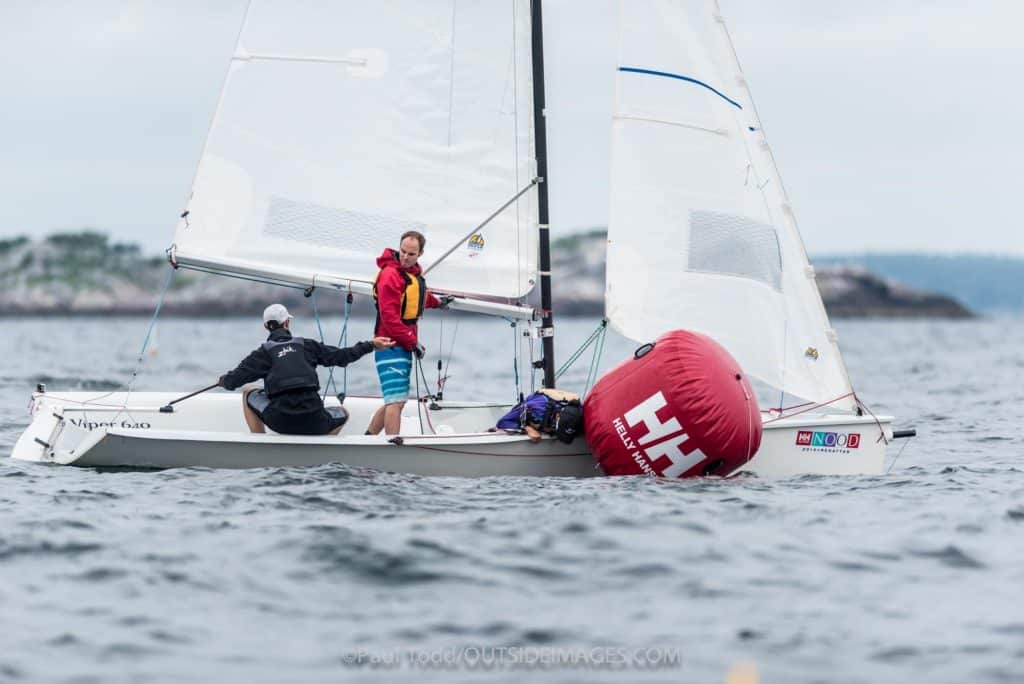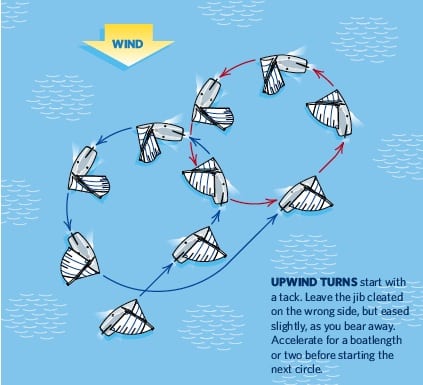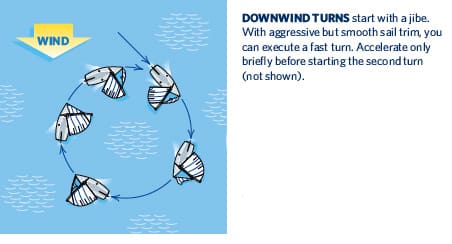
What I learned while sailing in college is that, if you’re going upwind, start your penalty circles by tacking first, and if you’re going downwind, start your penalty turns with a jibe. Years later, this rule of thumb is still the first thing to know about executing the fastest penalty turns. There are two reasons for doing so: 1. You accelerate out of a down-speed jibe more quickly than out of a down-speed tack. 2. You don’t sail any more distance away from the next mark than necessary. Different boats require certain mechanics to sail most efficiently through the turns, but the following guide should serve as a good starting point. Here’s how the basics of a faster penalty turn break down.

Upwind penalty turns
Why would you start your windward-leg turns with a tack? If you’re sailing upwind at full speed and bear away, essentially you’re sailing very quickly downwind, in the opposite direction of where you want to go. Tink of a windward mark where one boat tacks and then bears away while another boat just does a bear-away set. After a few seconds, the boat that does a bear-away is always further ahead, further downwind, which is the opposite direction you’re trying to go, if you are on a beat.
If you start your circles with a tack, your tack will be at full speed. Coming out of that tack, your boatspeed will be less than if you bore away, which means you won’t be sailing downwind as far before you jibe. For example, if you were in a Melges 32, sailing in 12 knots of wind, and simply bore away, you would be going downwind at 9 knots. But if you tacked first, then bore away, your speed downwind before the jibe would be 5 to 5.5 knots. Once you jibe, you can do a powerful turn up with speed, accelerate for 2 to 3 seconds, and then start your second circle with a tack (see the diagram above). It’s important to understand what the rules say about penalty turns. The turns must be started “promptly” in the same direction, but don’t necessarily need to be in a continuous motion. In other words, you don’t need to roll right into your second turn immediately after the first. I typically do one turn, accelerate briefly—one to two boatlengths, not 10—then start my second circle. This enables the boat to get back to speed before driving it through the next circle. A lot of this depends on wind velocity and the boat. In a dinghy, you can often spin within the length of the boat. Use your body weight to steer, coupled with rapid easing and trimming the sails.
On bigger boats, the key to efficiently completing an upwind penalty is communication, since they rely so heavily on sail trim to maneuver the boat through the turns. If the boat is turned before the main and headsail sheets are cleared and ready to go, you’re never going to make efficient circles. And once the crew is ready, it’s important that you have one person calling the trim: “Main in, jib out,” “Jib in, main out.” The reason for this is that many boats suffer from “heads-down” boat handling— grinders focusing on their winches as they grind and trimmers watching the sheet around the winch to prevent overrides. As a result, they may not be able to coordinate sail trim to facilitate the turns. The person calling the trim needs to follow two simple rules: To get the boat to bear off, backwind or over-trim the headsail while under-trimming the main. Make sure the vang is eased. Do the opposite to head up—over-trim the main and under-trim the headsail. If you have a non-overlapping jib, keep the jib trimmed on the tack you were on before beginning the circles. Ten, leave the sail on that side of the boat, backed but eased slightly, for your turn down and the ensuing jibe. Once again, the jib will be on the correct side, but it must be eased as you turn through the jibe so it doesn’t work against the turn as the boat heads up. The key to mainsail trim is rapid and extreme easing and trimming— it will be either all the way out or all the way in (see diagram at right). For easing, you can even go as far as dropping the mainsheet—just letting it run.
It’s important on a big boat to think about where people go. For instance, the jib trimmer is going to need someone to grind for him. On a boat like a Farr 40, where you have two mainsheet winches, put grinders on both winches. The trimmer then pulls the sheet on one side, and someone is grinding on both sides. When the command to trim is made, both winches are turning, but only one person does the easing. It’s the same setup you would use in pre-start maneuvers.
Spins at the windward mark
If you foul somebody at the weather mark, the rules say that you need to get clear of the other boats before you do way to do this is to complete your mark rounding and then reach away from the fleet. If there’s an offset mark, reach past the offset and do your penalty out beyond it. If the offset is a long way from the weather mark, you might continue to sail upwind, instead of bearing off for the offset, then do your circles above the offset leg. That’s a tough one though; by the time you sail far enough up to be able to turn and circle a couple of times, it’s probably quicker to go beyond the offset mark, which is why I try to never try to do circles between the weather mark and the offset mark. Make sure you’re far enough from the windward mark (or offset mark) so you can start your circles with a jibe without then turning up into boats bearing away at the offset mark.

Turns on the run
Why start downwind penalties with a jibe? Think about jibing around a leeward mark, heading up and immediately tacking. The first part of the penalty turn is just like that. This is pretty easy on a dinghy, but once you add a spinnaker to the equation or a much larger boat, with a lot of crewmembers, it becomes more an issue of communication, and of getting the jib up and the kite down. Here’s where practicing really pays. Raise the jib and, if you have a symmetrical spinnaker, take the pole down. Sail your normal course to the mark until your team is ready to do the turns. If you have a big staysail, you may not have to put the jib up, and you can trim the staysail for the turns as you would the jib. The quickest and cleanest way to deal with the spinnaker is to jibe onto the spinnaker, often known as a “Mexican” or “Kiwi” takedown. That way, you jibe, and the spinnaker falls onto the boat. That also leaves the chute on the correct side for hoisting once the turns are completed.
Decide whether the spinnaker needs to be put below deck or if it can be held on deck. Once the spinnaker is down, manage your circles, in terms of sail trim and boathandling, just as with an upwind penalty. You don’t need to accelerate between downwind circles for quite as long. The goal is to complete the turns and get your spinnaker up and drawing as quickly as possible.
Pro Tip: In the midst of the possible chaos caused first by the reason for having to do penalty turns and then having to actually execute the turns, it’s easy to lose track of just how many turns you have made. Assuming you have at least one other person on the boat with you, assign someone other than the skipper to count tacks and jibes during the penalty turns. Otherwise, you might find yourself in the protest room for not having completely fulfilled the penalty or, equally disastrous, giving up valuable distance by doing more turns than necessary.
This tip originally appeared in our November/December 2010 issue.









